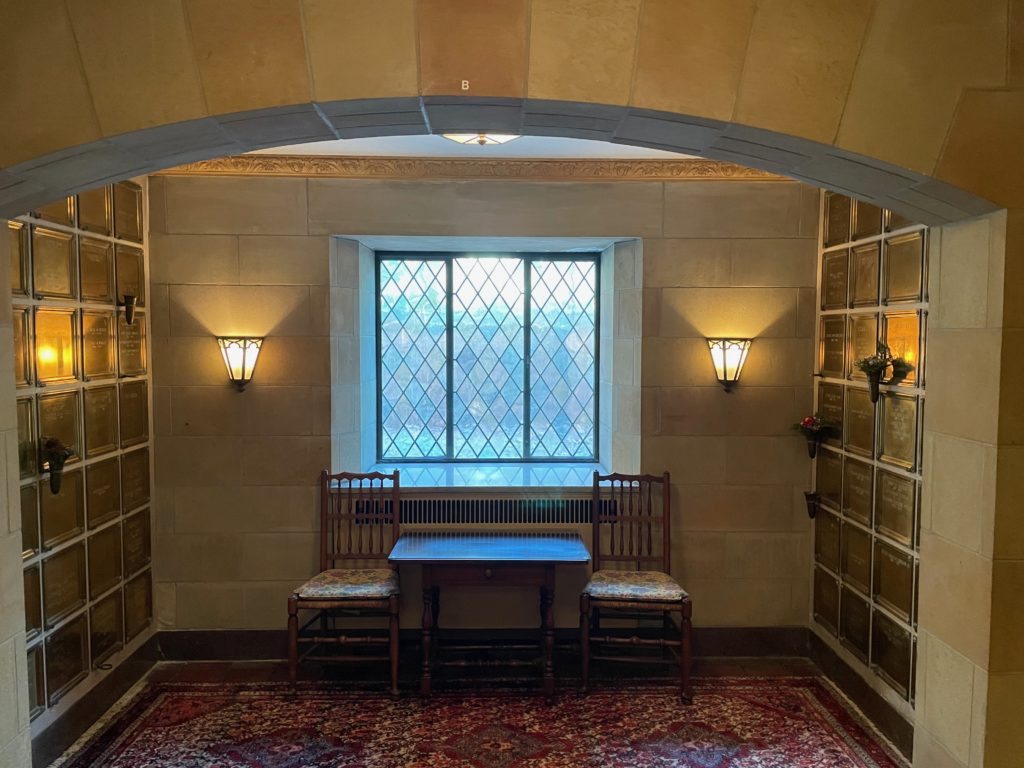Erik Visits an American Grave, Part 1,263
Somewhere in this section of this columbarium lies the unmarked grave of Walter Bradford Cannon.

Born in 1871 in Prairie du Chien, Wisconsin, Cannon came from an old French-Canadian family that embraced the intellectual world. The family was super Calvinist and this was something he fought against his whole life. He was able to go to Harvard, where he graduated in 1896, so he definitely started late, in 1892. But not sure how that all went down. I imagine that a kid from the provinces simply needed more education before being able to get into somewhere like Harvard. He then went to Harvard Medical School, where he finished in 1900.
While at Harvard Medical, Cannon became interested in physiology. In particular, he was super interested in the science of digestion. He helped pioneer the use of x-rays to study digestion. In all this, he worked with Henry Pickering Bowditch, the pioneering physiologist and psychologist. Harvard kept him on to teach and research in physiology. He became chair of the department in 1906 and kept that position until 1942, which is completely insane to me, though I suppose department chair was less onerous back then than it is in the collapsing university system of the present. He also became president of the American Physiological Society in 1914 for a two year term.
In 1901, Cannon married Cornelia James, who was a pretty interesting person too. She was a feminist, which he evidently supported, a Radcliffe graduate, a Planned Parenthood activist, and a suffragist in Massachusetts. She’s not really famous today and I don’t know much about her, but she is well worth mentioning. They were also both into mountain climbing, which was become a new sport for the elite at this time, with wealthy people exploring the West. They honeymooned on the recently seized Blackfeet lands that became Glacier National Park and were the first whites to climb the southwest peak of Goat Mountain. The USGS later named in Cannon Peak to honor the conquering whites, as it did with so many places. Little wonder that such histories and nomenclature remains highly controversial today.
Professionally, Cannon was pretty wide-ranging. He moved on from his digestion studies to engage in a number of career phases, which he realized himself were discrete parts in his life as he described them in his memoir. He worked on the shock of wounds, on the chemical mediation of nerve impulses, on the chemical sensitivity of nerve-isolated organs, and a bunch of other stuff that I don’t really understand very well. He had done some medical work during World War I and that is what started his research on wounds and shock.
One thing that Cannon did do, at least purportedly, is coin the term “fight or flight,” used so often today. He used it to describe the response of animals and coined it in his book Bodily Changes in Pain, Hunger, Fear and Rage: An Account of Recent Researches into the Function of Emotional Excitement. This was part of a larger discussion of adrenaline. He also brought the concept of homeostasis, or the steady internal systems of living beings, into the public discourse. He didn’t totally invent this idea but he did develop it with a lot more research. He also helped pioneer the idea of psychosomatic medicine. He was a big author and tried to reach out to the general public, which explains a lot about his ultimate influence. This culminated in a 1945 autobiography titled The Way of an Investigator: A Scientist’s Experiences in Medical Research.
Cannon also was politically active. For one, he was an active defender of animal experimentation, which was at the basis of a lot of his work. He was willing to speak out publicly on this, which is tough because animal experimentation is a pretty horrible thing. More usefully, he was active in speaking out against fascism and especially how it was impossible to do good science under a fascist government. Cannon was not a communist, but he was sympathetic to the Soviet attempts to make the world a better place and wanted scientific cooperation between the U.S. and the USSR. As such, he headed Medical Bureau to Aid Spanish Democracy and the American– Soviet Medical Society in the late 1930s.
Cannon was often considered a likely Nobel Prize winner, but it never happened. He died in New Hampshire in 1945. He was 73 years old. Walter Bradford Cannon, and presumably Cornelia James Cannon, are buried in Mount Auburn Cemetery, Cambridge, Massachusetts. I am not precisely sure which spot he is in, a lot of them unmarked. I was however able to definitively get it down to that specific set of plots.
If you would like this series to visit other heads of the American Physiological Society, you can donate to cover the required expenses here. Eugene Landis is in Palm, Pennsylvania and Robert Berne is in Charlottesville, Virginia. Previous posts in this series are archived here.


